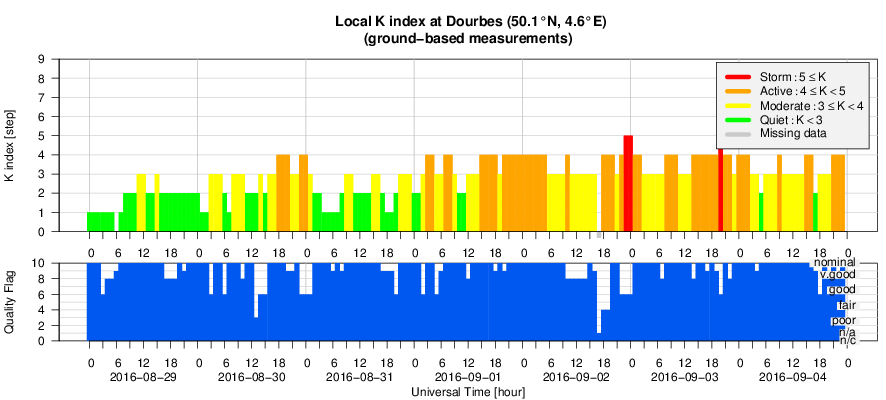- Table of Content
- 1.Another Eclips...
- 2.PROBA2 Observa...
- 3.Review of sola...
- 4.The Internatio...
- 5.Geomagnetic Ob...
- 6.Review of iono...
- 7.Future Events
- 8.New documents ...
2. PROBA2 Observations (29 Aug 2016 - 4 Sep 2016)
3. Review of solar and geomagnetic activity (29 Aug 2016 - 4 Sep 2016)
4. The International Sunspot Number
5. Geomagnetic Observations at Dourbes (29 Aug 2016 - 4 Sep 2016)
6. Review of ionospheric activity (29 Aug 2016 - 4 Sep 2016)
7. Future Events
8. New documents in the European Space Weather Portal Repository
Another Eclipse seen by PROBA2
On September 1, an annular solar eclipse took place in Africa. PROBA2 was able to observe this event as a partial eclipse from space. In fact, the Moon passed 6 times into the satellite’s view and we observed 4 occultations of the solar disk.
The LYRA profiles nicely showed the different responses of the Ly-alpha and the coronal channels to the occultation of different active regions.
And of course, SWAP taped the complete celestial event.
Read the whole story on the PROBA2 website: http://proba2.oma.be/node/316
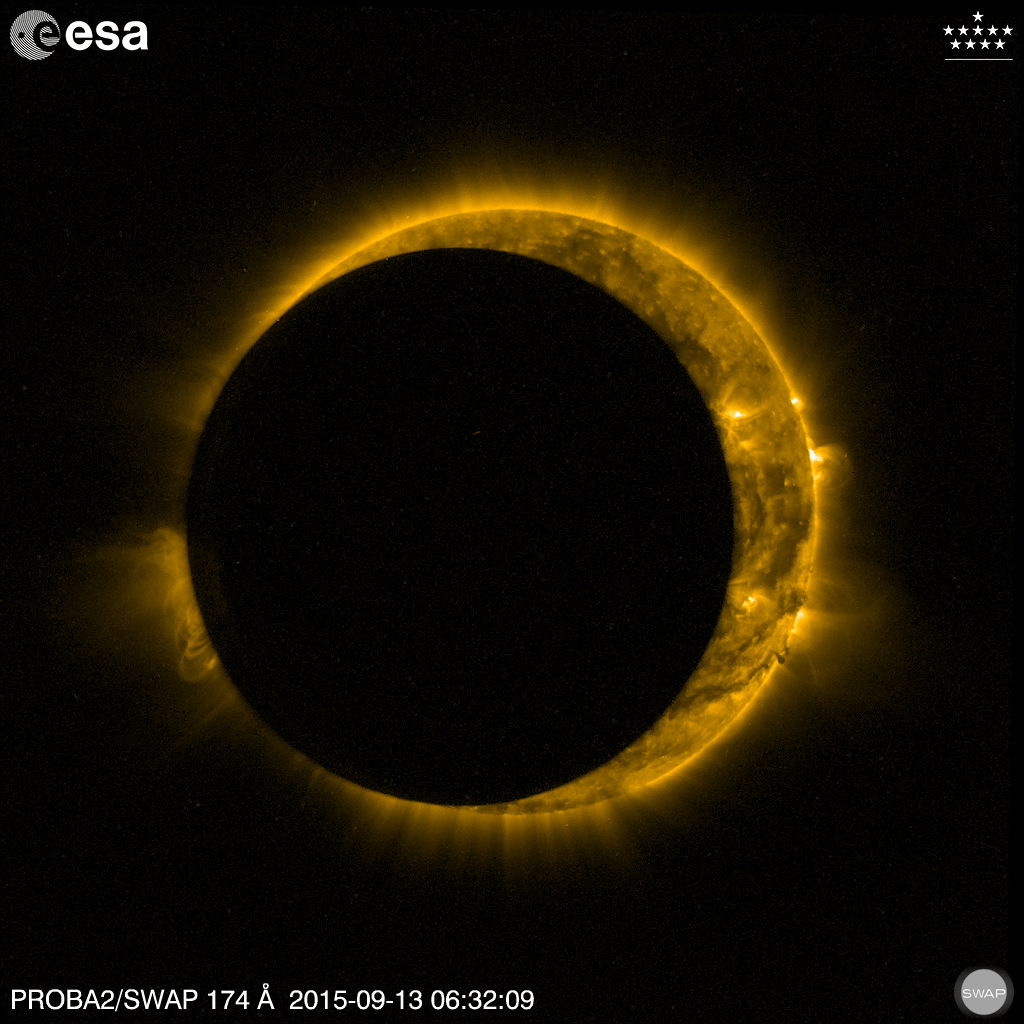
PROBA2 Observations (29 Aug 2016 - 4 Sep 2016)
Solar Activity
Solar flare activity fluctuated between very low and low during the week.
In order to view the activity of this week in more detail, we suggest to go to the following website from which all the daily (normal and difference) movies can be accessed: http://proba2.oma.be/ssa
This page also lists the recorded flaring events.
A weekly overview movie can be found here(SWAP week 336)
http://proba2.oma.be/swap/data/mpg/movies/weekly_movies/weekly_movie_2016_08_29.mp4.
Details about some of this week’s events, can be found further below.
Thursday Sep 01
If any of the linked movies are unavailable they can be found in the P2SC movie repository here:
http://proba2.oma.be/swap/data/mpg/movies/
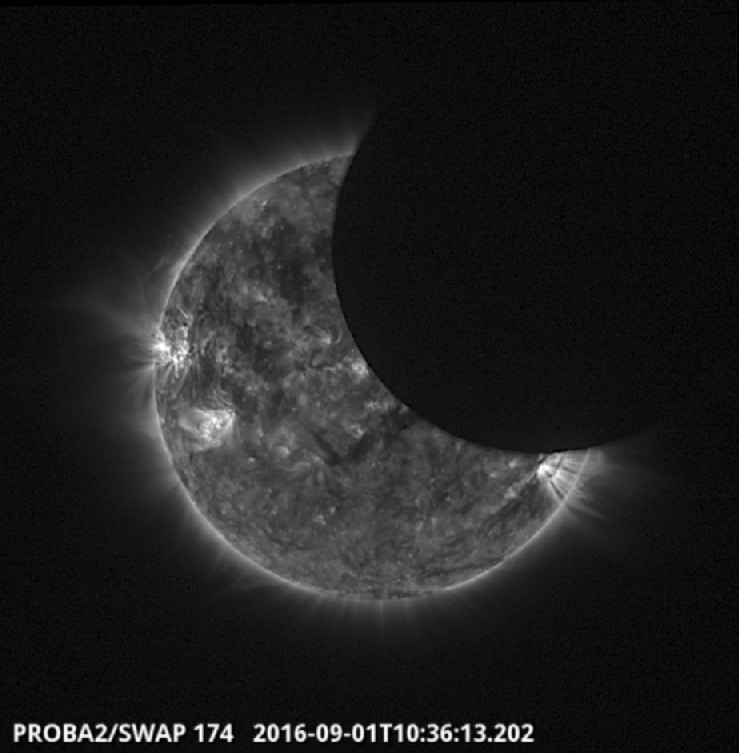
Eclipse Campaign for SWAP images
Find a movie of the events here(SWAP movie)
http://proba2.oma.be/Events/2016-09-01-AnnularEclipse/movie/swap_eclipse_2016_09_01_logos_lossless.mp4
Sunday Sep 04
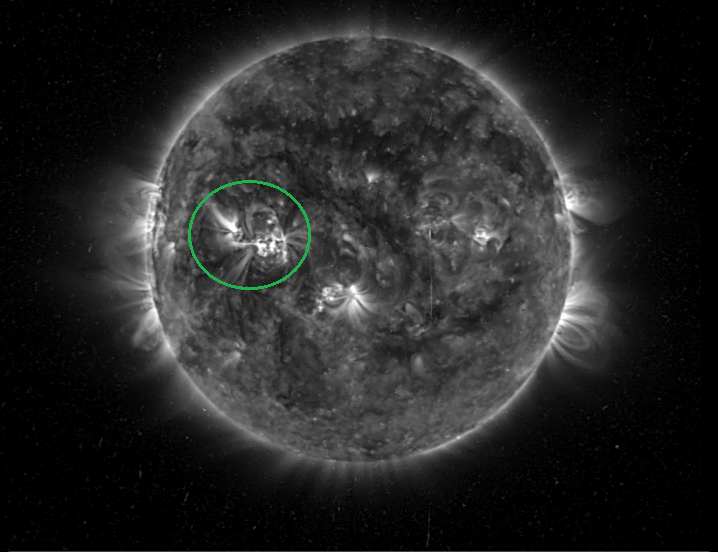
Very large sunspot group (NOAA 2585) on SWAP images which has been visible for the whole week and was quiet (B and C flares).
Find a movie of the events here (SWAP movie)
http://proba2.oma.be/swap/data/mpg/movies/weekly_movies/weekly_movie_2016_08_29.mp4
Review of solar and geomagnetic activity (29 Aug 2016 - 4 Sep 2016)
Solar Activity
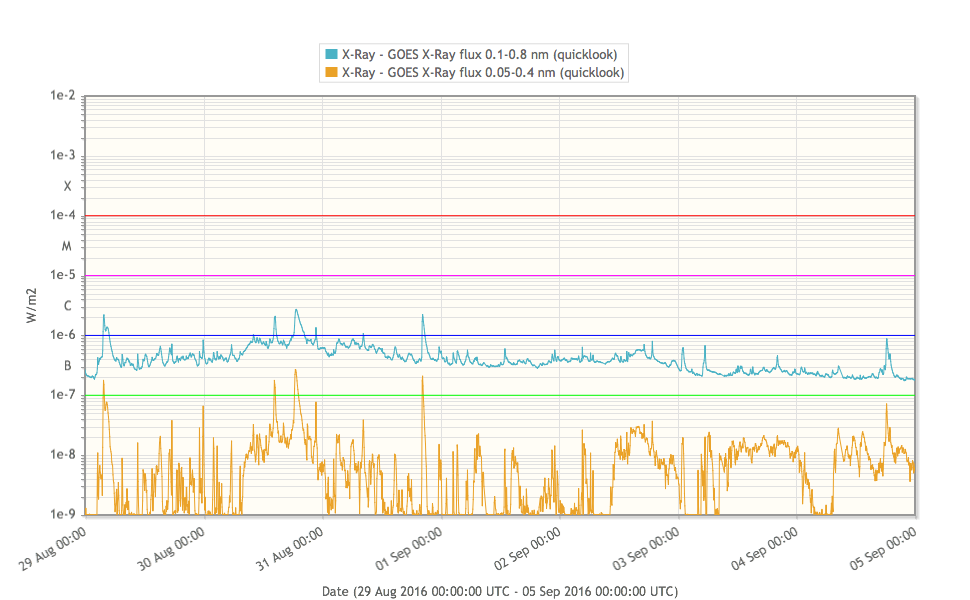
Solar activity was low throughout the week. Only minor C-class flares occurred (the strongest was a C2.2 on August 31).
No Earth directed CMEs were recorded and solar proton fluxes remained at background levels.
Geomagnetic Activity
The Earth was under the influence of a high speed solar wind from September 1 onwards. Solar wind speeds reached peaks of close to 800 km/s with Bz oscillating between 5 and -5 nT. For sure, the big positive polar coronal hole (CH) influenced the solar wind strongly. But it is difficult to distinguish in a quantitive way between the influence of the southern, also positive, CH and the big polar CH.
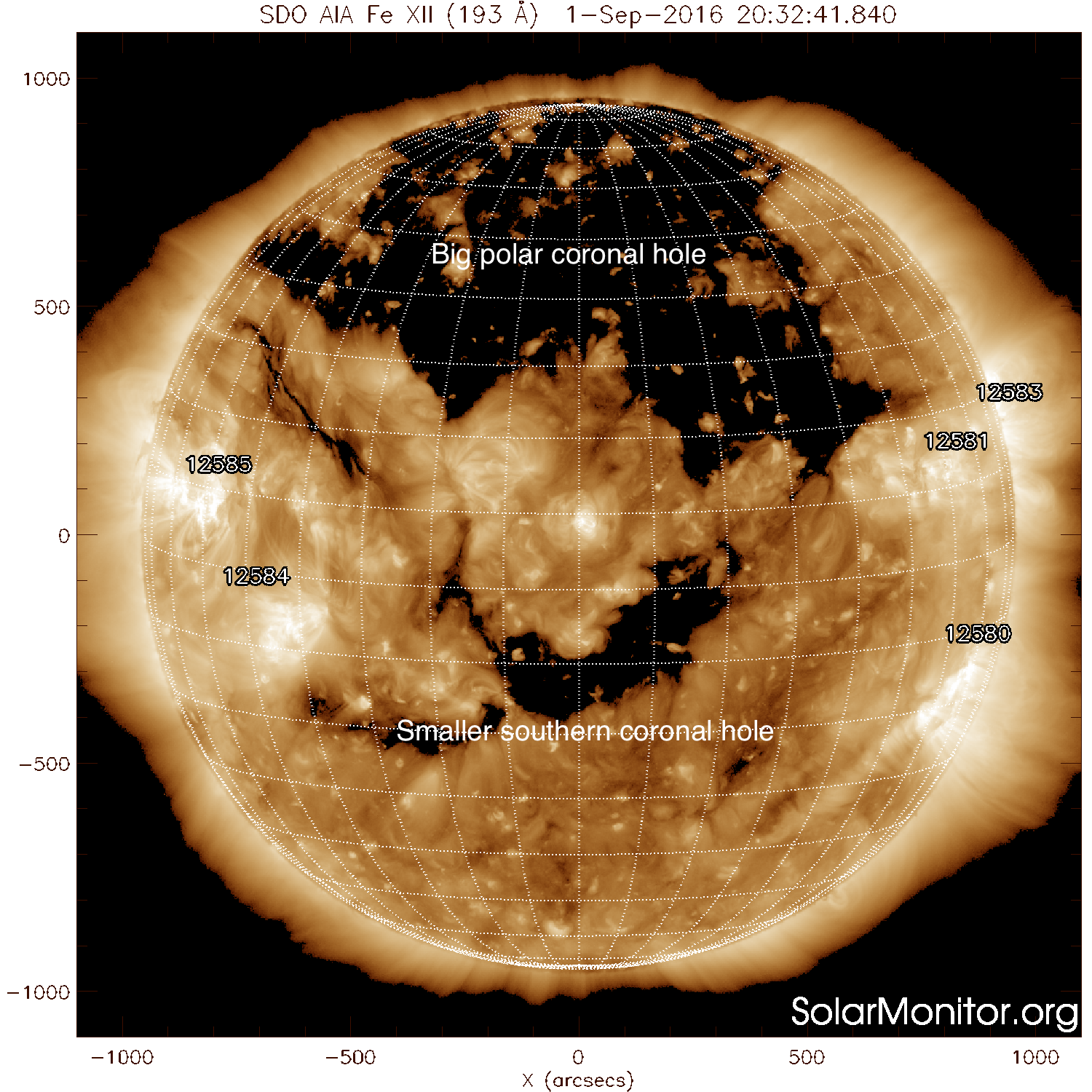
This situation created periods of increased geomagnetic activity (K at Dourbes reaching 5 and Kp going up to 6) between September 1 and September 4.
Remark: the length of the weekly bulletin is also an indicator for solar and geomagnetic activity.
The International Sunspot Number
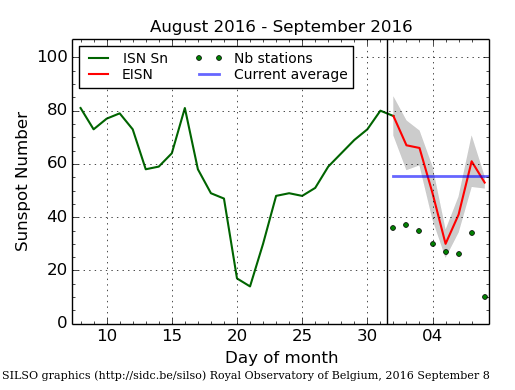
The daily Estimated International Sunspot Number (EISN, red curve with shaded error) derived by a simplified method from real-time data from the worldwide SILSO network. It extends the official Sunspot Number from the full processing of the preceding month (green line). The plot shows the last 30 days (about one solar rotation). The horizontal blue line shows the current monthly average, while the green dots give the number of stations included in the calculation of the EISN for each day.
Review of ionospheric activity (29 Aug 2016 - 4 Sep 2016)
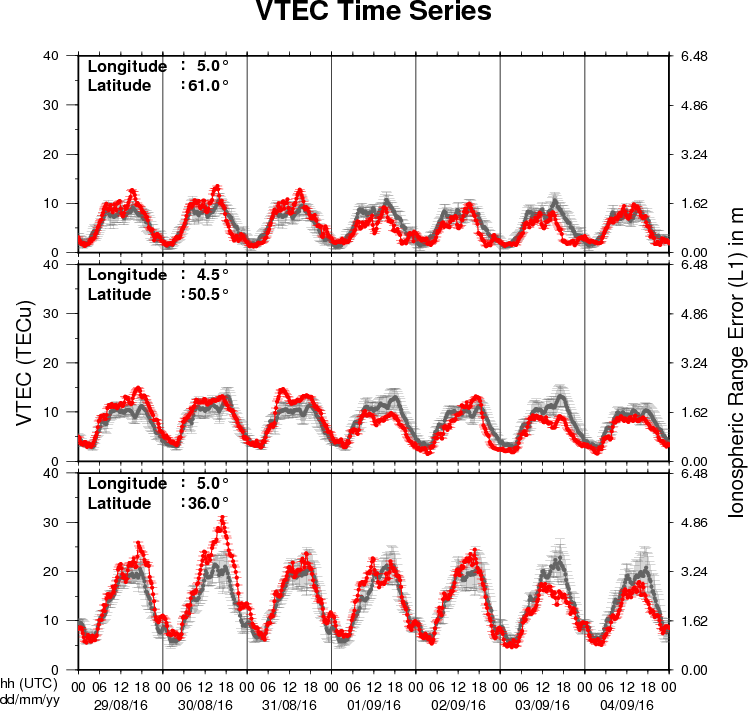
The figure shows the time evolution of the Vertical Total Electron Content (VTEC) (in red) during the last week at three locations:
a) in the northern part of Europe(N61°, 5°E)
b) above Brussels(N50.5°, 4.5°E)
c) in the southern part of Europe(N36°, 5°E)
This figure also shows (in grey) the normal ionospheric behaviour expected based on the median VTEC from the 15 previous days.
The VTEC is expressed in TECu (with TECu=10^16 electrons per square meter) and is directly related to the signal propagation delay due to the ionosphere (in figure: delay on GPS L1 frequency).
The Sun's radiation ionizes the Earth's upper atmosphere, the ionosphere, located from about 60km to 1000km above the Earth's surface.The ionization process in the ionosphere produces ions and free electrons. These electrons perturb the propagation of the GNSS (Global Navigation Satellite System) signals by inducing a so-called ionospheric delay.
See http://stce.be/newsletter/GNSS_final.pdf for some more explanations ; for detailed information, see http://gnss.be/ionosphere_tutorial.php
Future Events
For more details, see http://www.spaceweather.eu/en/event/future
Horizon 2020 Space Work Programme 2018-2020 Stakeholder Consultation Workshop, in Brussels, Belgium
Start : 2016-09-26 - End : 2016-09-28
In the context of preparing the Horizon 2020 Space work
programme 2018-2020, the European Commission organises a dedicated
stakeholder consultation workshop. The main objective of this event
is to further involve all relevant European stakeholders in the
definition of the next Horizon 2020 Space work programme,
highlighting the main priorities and trends.
The participation to the workshop is free and open to all
relevant stakeholders, limited only by the capacity of the
conference rooms. Delegations, European associations and other
stakeholder groups are encouraged to forward this invitation to
their respective constituents and members.
Website:
https://h2020-space-wp-2018-20.teamwork.fr/en/programme
4th Asia Oceania Space Weather Alliance (AOSWA) Workshop, in Jeju, Republic of Korea
Start : 2016-10-24 - End : 2016-10-27
Website:
http://aoswa4.spaceweather.org/index.php
Global Modelling of the Space Weather Chain in Helsinki, Finland
Start : 2016-10-24 - End : 2016-10-28
This event brings together solar, heliospheric, magnetospheric,
and ionospheric communities to discuss the current state and future
challenges in global modelling of the entire space weather chain.
Major developments in forecasting space weather, and understanding
the effects of solar eruptions requires increased communication and
collaboration of these often rather distinct communities. We
welcome submissions from these modelling communities and also
synergetic studies utilising both observations and numerical
models.
Website:
https://pnst.ias.u-psud.fr/sites/pnst/files/global_modelling_space_weather_oct2016.pdf
European Space Weather Week in Ostend, Belgium
Start : 2016-11-14 - End : 2016-11-18
The ESWW is the main annual event in the European Space Weather
calendar. It is the European forum for Space Weather as proven by
the high attendance to the past editions. The agenda will be
composed of plenary/parallel sessions, working meetings and
dedicated events for service end-users. The ESWW will again adopt
the central aim of bringing together the diverse groups in Europe
working on different aspects of Space Weather.
Website:
http://www.stce.be/esww13/
4th SOLARNET Meeting: The Physics of the Sun from the Interior to the Outer Atmosphere, in Lanzarote (Spain)
Start : 2017-01-16 - End : 2017-01-20
The IV SOLARNET MEETING 'The physics of the Sun from the
interior to the outer atmosphere' will take place in Lanzarote
(Spain) from 16th to 20th of January 2017, organized by the
Instituto de AstrofÃsica de Canarias (IAC).
SOLARNET (High-resolution Solar Physics Network) is an EU-FP7
project coordinated by IAC with the aim of bringing together and
integrating the major European research infrastructures in the
field of high-resolution solar physics. SOLARNET involves all
pertinent European research institutions, infrastructures, and data
repositories. Networking activities, access to first-class
infrastructures and joint research and development activities are
being covered under SOLARNET to improve, in quantity and quality,
the service provided by this European community.
The purpose of this conference is to provide a coherent picture
of the Sun as a single physical system playing all the underlying
physical processes measured and observed in the solar atmosphere to
date.
Website:
http://www.iac.es/congreso/solarnet-4meeting/
Solar Orbiter Workshop 7: Exploring the solar environs in Granada, Spain
Start : 2017-04-03 - End : 2017-04-06
This event will be hosted by the Instituto de Astrofisica de
Andalucia - CSIC. Please mind that on April 7th the 20th SWT
meeting will take place at the same venue.
Website: Unkown
New documents in the European Space Weather Portal Repository
See http://www.spaceweather.eu/en/repository
STCE - Het Solar Indices Data analysis Center: De voorspelling van het Ruimteweer
Generalities on Space Weather; SIDC SW forecast team (who, what, how, tools, products).
Given to the solar section of the VVS on 4 June 2016. 20 participants.
http://www.spaceweather.eu/en/repository/show?id=608
STCE - Het nieuwe zonnevlekkengetal: Een kleine samenvatting van een grote verandering
History of the sunspot number; reasons for revision; methodology; major changes and why; consequences on solar cycle and scientific research; group number changes; the new SILSO outlook.
Given to the solar section of the VVS on 4 June 2016. 20 participants.
http://www.spaceweather.eu/en/repository/show?id=609
STCE - Zonneactiviteit en ruimteweer tijdens zonnecyclus 24
General introduction to sunspots, solar cycle, solar eruptions, space weather, major solar storms (history), SIDC and SW prediction, major solar storms during current solar cycle (SC24) and SWx effects.
Given to the VVS / De Sterrenjutters (Koksijde, Belgium) on 2 September 2016. 20 participants.
http://www.spaceweather.eu/en/repository/show?id=610
